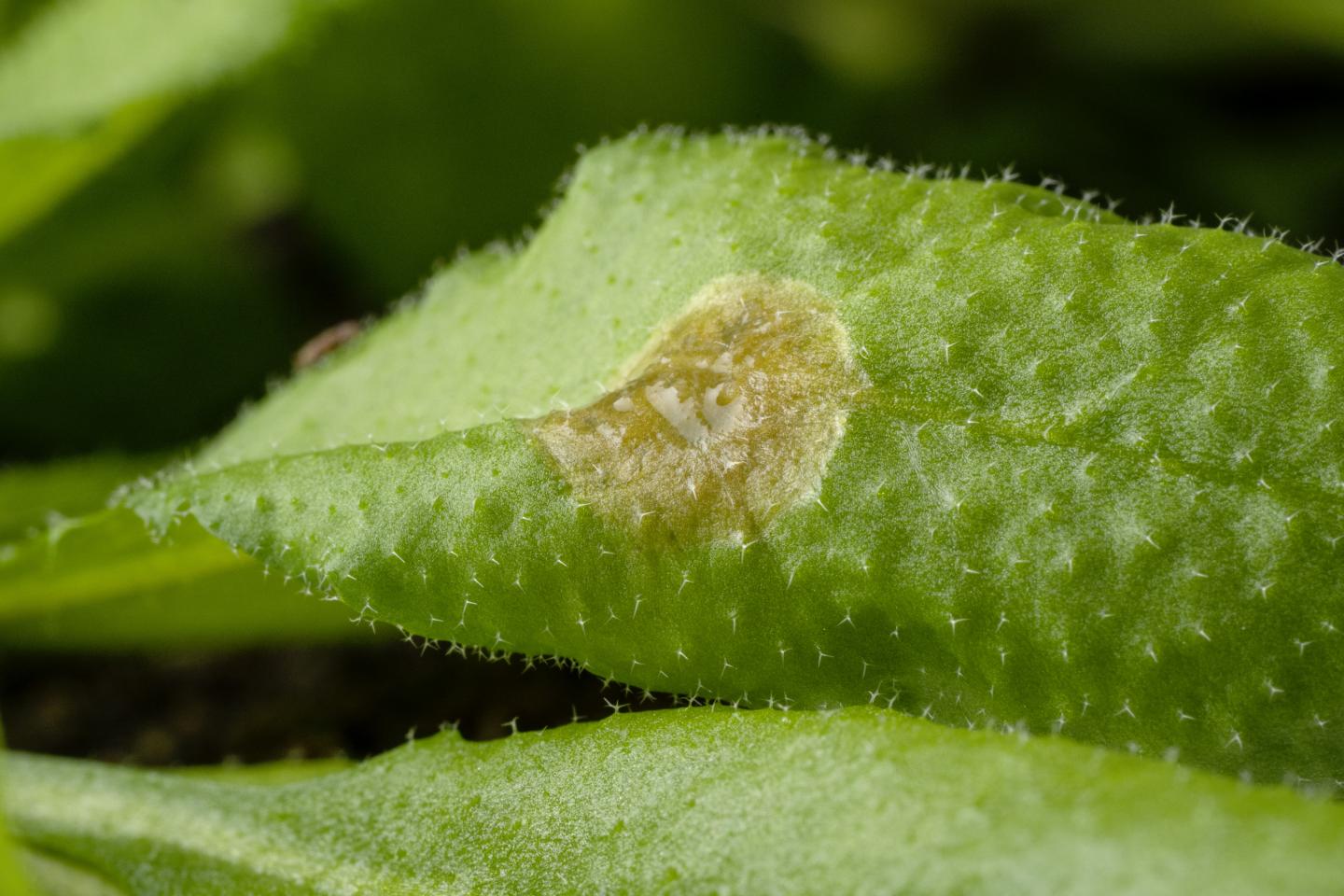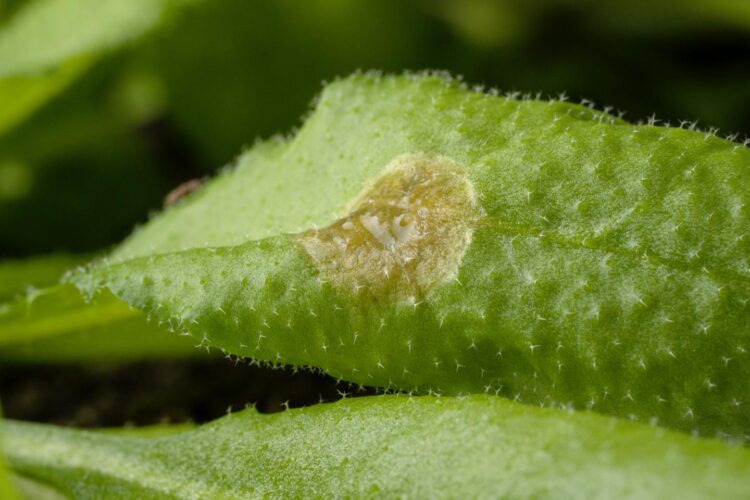The white mold fungus Sclerotinia sclerotiorum detoxifies the mustard oil bomb in plants of the cabbage family

Credit: Anna Schroll
Cabbage plants defend themselves against herbivores and pathogens by deploying a defensive mechanism called the mustard oil bomb: when the plant tissue is damaged, toxic isothiocyanates are formed and can effectively fend off attackers. Researchers at the Max Planck Institute for Chemical Ecology and the University of Pretoria have now been able to show in a new study that this defense is also effective to some extent against the widespread and detrimental fungus Sclerotinia sclerotiorum. However, the pathogen uses at least two different detoxification mechanisms that enable the fungus to successfully spread on plants defended in this way. The metabolic products thus formed are non-toxic to the fungus, allowing it to grow on these plants (Nature Communications, June 2020, DOI 10.1038/s41467-020-16921-2).
Sclerotinia sclerotiorum is a devastating fungal pathogen that can infect more than 400 different plant species. The main symptom of the disease called Sclerotinia wilt or white mold is wilting. Visible are also the white, cotton-like fungal spores that overgrow plant leaves and stalks. In agriculture, rapeseed cultivation is particularly at risk. The plant disease can affect other members of the cabbage family, and also potatoes, legumes and strawberries.
Scientists at the Max Planck Institute for Chemical Ecology in Jena have long been studying the glucosinolates and isothiocyanates that constitute the special defense mechanism of cabbage family plants, which include rapeseed, radishes and mustard. “We wanted to find out how successful plant pathogens overcome the plant defense and colonize these plants. We therefore asked ourselves whether widespread fungal pathogens have strategies to adapt to the chemical defenses of plants of the cabbage family,” Jingyuan Chen, the first author of the study, explains.
The researchers were able to show experimentally that the defense based on glucosinolates is actually effective against fungal attacks. However, they also discovered two different strategies of the white mold fungus to detoxify the defensive substances: The first is a general detoxification pathway that binds glutathione to the isothiocyanate toxins. This type of detoxification of organic poisons is quite common in insects and even mammals. The second and far more effective way to render the isothiocyanates harmless is to hydrolyse them, i.e. to cleave them enzymatically with a water molecule. The researchers wanted to identify the enzymes and corresponding genes underlying this detoxification mechanism. Genes that enable the successful detoxification of these substances had already been described in bacteria. They are called Sax genes after experiments with the model plant Arabidopsis thaliana: Survival in Arabidopsis eXtracts.
“We based our search on the known bacterial SaxA proteins to select candidate genes for further investigations. We then tested whether these genes are actually expressed in greater quantities in fungi exposed to the toxins, and whether the resulting protein can render the toxins harmless,” explains Daniel Vassão, one of the study leaders. Using high-resolution analytical methods, the scientists were able to identify and quantify the metabolites produced by the fungus during detoxification. They also used mutants of the fungus in which the SaxA-encoding gene had been knocked out for comparison. This revealed that the Sax protein of the white mold fungus is active against a range of isothiocyanates, allowing it to colonize different plants of the cabbage family.
Mutants lacking the gene for this detoxification pathway were dramatically reduced in their capacity to tolerate isothiocyanates. “However, it was surprising to see that these mutants up-regulated their general pathway of detoxification, although this did not compensate for the mutation,” says Jingyuan Chen. Glutathione conjugation cannot detoxify isothiocyanates nearly as effectively as hydrolysis can. Although it seems to be metabolically more expensive for the fungus, this general pathway is always present as it helps the fungus to detoxify a huge variety of poisons. “It is possible that this general pathway protects the fungus initially, while the machinery required for the more specialized pathway is assembled after an initial exposure to the toxin and can take over later in the infection,” says Daniel Vassão.
In further experiments, the researchers want to investigate whether other fungi that successfully infect plants of the cabbage family also detoxify isothiocyanates via the same pathway, and whether unrelated fungal species are also able to degrade these toxins. “Then we will know whether this widespread detoxification is due to repeated evolution in fungi colonizing mustards, or is a feature which has been conserved over time and is therefore found in many fungal lines,” Jonathan Gershenzon, director of the Department of Biochemistry where the research was conducted, concludes.
###
Original publication:
Chen, J., Ullah, C., Reichelt, M., Beran, F., Yang, Z.-L., Gershenzon, J., Hammerbacher, A., Vassão, D. G. (2020). The phytopathogenic fungus Sclerotinia sclerotiorum detoxifies plant glucosinolate hydrolysis products via an isothiocyanate hydrolase. Nature Communication 11: 3090, DOI 10.1038/s41467-020-16921-2
https:/
Further Information:
Dr. Daniel Giddings Vassão, Max Planck Institute for Chemical Ecology, Hans-Knöll-Straße 8, 07745 Jena. Tel. +49 3641 57-1333, E-Mail [email protected]
Dr. Almuth Hammerbacher, Department of Zoology and Entomology, Forestry and Agricultural Biotechnology Institute, University of Pretoria, Pretoria, 0028 South Africa, E-Mail [email protected]
Prof. Dr. Jonathan Gershenzon, Max Planck Institute for Chemical Ecology, Hans-Knöll-Straße 8, 07745 Jena. Tel. +49 3641 57-1300, E-Mail [email protected]
Contact and Picture Requests:
Angela Overmeyer M.A., Max Planck Institute for Chemical Ecology, Hans-Knöll-Str. 8, 07743 Jena, Germany, Tel. +49 3641 57-2110, E-Mail [email protected]
Download of high-resolution images via http://www.
Media Contact
Dr. Daniel Giddings Vassão
[email protected]
Original Source
http://www.
Related Journal Article
http://dx.





